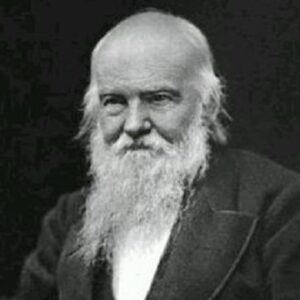James Young, the pioneer of the petrochemical industry, was a Scottish chemist, engineer, and the founder of the world’s first commercial oil works. He was born to a cabinetmaker, John Young, and led a modest life. In the mornings, he worked as an apprentice for his father. From the age of 19, he took evening school at Anderson’s College. It was there that he met Thomas Graham, a chemistry lecturer. He was employed as Graham’s assistant and became David Livingstone’s friend. The modification of the voltaic battery was his first significant contribution to science. To fight potato blight, he advocated soaking potatoes in dilute sulphuric acid. He created lubricating oil as well as a lighter oil for burning. His most significant accomplishment, for which he became known as James “Paraffin” Young, was the development of a method for obtaining paraffin oil from coal through distillation. In the United States and the United Kingdom, he patented his product. He was elected a Fellow of the Royal Society and served as President of Anderson’s College, where he established the Young Chair of Technical Chemistry. The Manchester Literary and Philosophical Society elected him. At St. Andrews University, he received an Honorary LLD.
Childhood and Adolescence
James Young was born on July 13, 1811, in Glasgow, Scotland, to cabinetmaker John Young. Early in youth, he became an apprentice to his father and educated himself by attending night school.
From the age of 19, he worked in the mornings and attended evening lectures at Anderson’s College, where he met Thomas Graham, a chemistry lecturer.
Later Life & Career
James Young was chosen as Thomas Graham’s assistant in 1831, and he lectured on his behalf at times. He became friends with the great explorer David Livingstone while working at Anderson’s College.
In 1837, he published his first scientific work, which detailed a modification of Michael Faraday’s voltaic battery. Young travelled with Graham to University College, London, and assisted him with his experimental work.
In 1839, he was named manager of James Muspratt’s Newton-le-Willows, Merseyside. He joined Tennants, Clow & Co. in Manchester five years later, when he developed a method for producing sodium stannate straight from cassiterite.
While serving on the Manchester Literary and Philosophical Society’s committee for the examination of potato blight in 1845, he advocated immersing potatoes in dilute sulphuric acid as a method of combatting the disease.
Oil oozing from the Riddings colliery in Derbyshire was reported to him in 1847. He and Mr Edward Meldrum created a thick lubricating oil and a thin oil suitable for burning after much experimentation.
After leaving Tennants’ in 1848, he and Meldrum started a modest business refining crude oil. Despite the success of oil production, the supply of coal from the mine began to dwindle.
He and Meldrum formed a partnership with Edward William Binney and established the first commercial oil factory at Bathgate, producing naphtha and lubricating oils from oil derived from shale and bituminous coal.
He came to Scotland in 1852. In the United States, he patented the manufacturing of paraffin oil from coal distillation. His patent was upheld in the United States and the United Kingdom after a series of lawsuits.
In 1865, he bought out all of his partners and established Young’s Paraffin Light and Mineral Oil Company in Addiewell. The business manufactured and marketed paraffin oil as well as lamps.
In 1866, he sold his Addiewell and Bathgate factories but stayed on the board of directors, albeit he did not participate actively since he preferred to focus on his estates.
Young was the President of Anderson’s College from 1868 to 1877, and he established the Young Chair of Technical Chemistry at the college. In addition, he was made a Fellow of the Royal Society.
After discovering that bilge water was acidic, he proposed that iron ships could be made rustproof by employing quicklime to avoid corrosion. The Royal Navy eventually adopted it.
In an attempt to extract ammonia from sewage, he conducted sophisticated experiments in his laboratory at his Wemyss Bay home. He was quite successful, and his invention was patented.
Major Projects of James
Oil oozing from the Riddings colliery in Derbyshire was reported to him in 1847. He and Mr Edward Meldrum created a thick lubricating oil and a thin oil suitable for burning after much experimentation.
He realized that slow distillation could extract a variety of useful liquids from coal. “Paraffine oil,” which congealed at low temperatures, was one of these liquids. In 1850, he received a patent for his inventions.
Achievements & Awards
He received an Honorary LLD from St. Andrews University in 1879 and served as Vice-President of the Chemical Society for two years. The Manchester Literary and Philosophical Society elected him.
Personal History and Legacy
Young married Mary and they had three boys and four daughters together.
On May 13, 1883, he died at his home at Kelly, near Wemyss Bay, leaving behind his wife, three boys, and four daughters. He was laid to rest in Inverkip.
He was honored by the names James Young High School in Livingston and James Young Halls at the University of Strathclyde. He was elected to the Scottish Engineering Hall of Fame in 2011.
Estimated Net Worth
The estimated Net Worth of is James Young (Chemist) unknown.
Trivia
As a tribute to David Livingstone, who discovered the Victoria Falls in the mid-nineteenth century, this Scottish scientist erected a small duplicate of the “Victoria Falls” in Limefield House, where he lived.
This scientific researcher was a close friend of David Livingstone’s and helped fund a search for him after he went missing. He also arranged for the return of Livingstone’s servants to England.


